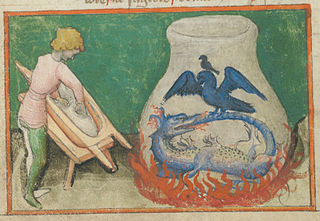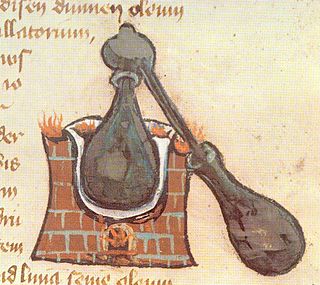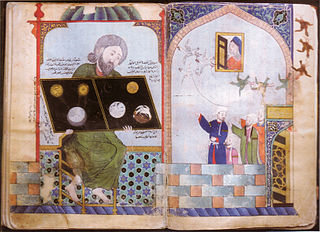
Alchemy is an ancient branch of natural philosophy, a philosophical and protoscientific tradition that was historically practised in China, India, the Muslim world, and Europe. In its Western form, alchemy is first attested in a number of pseudepigraphical texts written in Greco-Roman Egypt during the first few centuries AD.
Chemistry is the scientific study of the properties and behavior of matter. It is a physical science within the natural sciences that studies the chemical elements that make up matter and compounds made of atoms, molecules and ions: their composition, structure, properties, behavior and the changes they undergo during reactions with other substances. Chemistry also addresses the nature of chemical bonds in chemical compounds.

The Egyptian language or Ancient Egyptian is an extinct branch of the Afro-Asiatic languages that was spoken in ancient Egypt. It is known today from a large corpus of surviving texts, which were made accessible to the modern world following the decipherment of the ancient Egyptian scripts in the early 19th century. Egyptian is one of the earliest known written languages, first recorded in the hieroglyphic script in the late 4th millennium BC. It is also the longest-attested human language, with a written record spanning over 4,000 years. Its classical form is known as "Middle Egyptian." This was the vernacular of the Middle Kingdom of Egypt, and it remained the literary language of Egypt until the Roman period. By the time of classical antiquity, the spoken language had evolved into Demotic, and by the Roman era it had diversified into the Coptic dialects. These were eventually supplanted by Arabic after the Muslim conquest of Egypt, although Bohairic Coptic remains in use as the liturgical language of the Coptic Church.

Egyptian hieroglyphs were the formal writing system used in Ancient Egypt for writing the Egyptian language. Hieroglyphs combined logographic, syllabic and alphabetic elements, with more than 100 distinct characters. Cursive hieroglyphs were used for religious literature on papyrus and wood. The later hieratic and demotic Egyptian scripts were derived from hieroglyphic writing, as was the Proto-Sinaitic script that later evolved into the Phoenician alphabet. Through the Phoenician alphabet's major child systems, the Egyptian hieroglyphic script is ancestral to the majority of scripts in modern use, most prominently the Latin and Cyrillic scripts and the Arabic script, and possibly the Brahmic family of scripts.

An almanac is a regularly published listing of a set of current information about one or multiple subjects. It includes information like weather forecasts, farmers' planting dates, tide tables, and other tabular data often arranged according to the calendar. Celestial figures and various statistics are found in almanacs, such as the rising and setting times of the Sun and Moon, dates of eclipses, hours of high and low tides, and religious festivals. The set of events noted in an almanac may be tailored for a specific group of readers, such as farmers, sailors, or astronomers.

An alembic is an alchemical still consisting of two vessels connected by a tube, used for distillation of liquids.

The Emerald Tablet, the Smaragdine Table, or the Tabula Smaragdina is compact and cryptic Hermetic text. It was a highly regarded foundational text for many Islamic and European alchemists. Though attributed to the legendary Hellenistic figure Hermes Trismegistus, the text of the Emerald Tablet first appears in a number of early medieval Arabic sources, the oldest of which dates to the late eighth or early ninth century. It was translated into Latin several times in the twelfth and thirteenth centuries. Numerous interpretations and commentaries followed.
The Greek language has contributed to the English lexicon in five main ways:

Medinet Habu is an archaeological locality situated near the foot of the Theban Hills on the West Bank of the River Nile opposite the modern city of Luxor, Egypt. Although other structures are located within the area and important discoveries have also been made at these sites, the location is today associated almost synonymously with the largest and best preserved site, the Mortuary Temple of Ramesses III.

Muḥammad ibn Umayl al-Tamīmī, known in Latin as Senior Zadith, was an early Muslim alchemist who lived from c. 900 to c. 960 AD.
Rebracketing is a process in historical linguistics where a word originally derived from one set of morphemes is broken down or bracketed into a different set. For example, hamburger, originally from Hamburg+er, has been rebracketed into ham+burger, and burger was later reused as a productive morpheme in coinages such as cheeseburger. It is usually a form of folk etymology, or may seem to be the result of valid morphological processes.

Alchemy in the medieval Islamic world refers to both traditional alchemy and early practical chemistry by Muslim scholars in the medieval Islamic world. The word alchemy was derived from the Arabic word كيمياء or kīmiyāʾ and may ultimately derive from the ancient Egyptian word kemi, meaning black.
Kimia is an Ancient Greek word and a feminine given name in Persian language. It means elixir of life, alchemy, or the philosopher’s stone. In ancient Persian poetry, kimia means "rare" or "unique."







